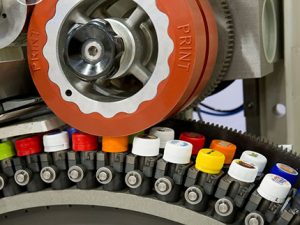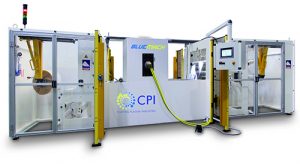Many engineering polymers have characteristically low surface energy and therefore exhibit intrinsically poor adhesion characteristics. The incorporation of oxygen into the surface of a polymer creates a higher surface energy, allowing the substrate to be more readily coated. Poor adhesion is also an important obstacle in achieving reliable glue joints for print adhesion applications onto materials widely used in the medical device industry, for example.
Plastic surfaces can be treated by three methods which rely on surface oxidation: plasma processing, corona treatment, and flame treatment. All involve cleavage of polymer chains in the material and the incorporation of carbonyl, and hydroxyl functional groups.
The characteristics, advantages and limitations of the three methods are summarised in Table 1.
Plasma processing has been an essential production tool for more than 30 years in the fabrication of microelectronic devices for example. Over this period, plasma processes have also permeated a much broader range of industries, including automotive, medical, textiles and plastics.
Today, plasmas are routinely used to clean and surface treat plastic automotive bumpers, performance textiles and filter media, stainless steel syringe needles, angioplasty balloon catheters, plastic lenses, golf balls, and many other diverse products.
Some plastics, including polypropylene (PP), polytetrafluoroethylene (PTFE), polyetheretherketone (PEEK) and acetal (POM) are homopolar and do not bond easily. Plasmas afford an effective surface activation pre-treatment prior to printing, lacquering or gluing. Glass and ceramics can similarly be plasma activated. It is a reliable and effective technique for increasing print adhesion and bond strength.
Parts remain active for a few minutes up to several months, depending on the particular material that has been plasma treated. For example, polypropylene can still be reprocessed several weeks after treatment.
Henniker Plasma is a leading UK-based manufacturer of plasma treatment equipment and processes, from low-cost benchtop plasma cleaners and plasma etchers for R&D applications, to industrial scale plant machines for high throughput processes.
Several of the company's clients use in-line atmospheric plasma surface treatment to successfully increase the surface energy of PEEK from 35mN/m to more than 72mN/m, ensuring permanent PAD print adhesion. The treatment remains active on PEEK for several weeks and so parts can be stored until needed.

In another example, vacuum plasma treatment of PTFE has been adopted for printing and gluing steps in catheter manufacture, where a PTFE surface is modified to produce a permanent change in surface energy from 18mN/m to more than 72mN/m.
Coating Plasma Industrie (CPI) is a pioneering company in cold plasma surface treatment located in the south of France. This process can be operated at atmospheric pressure or under vacuum in applications in packaging, printing, polymer transformation and textiles.
CPI is one of few companies capable of offering complete roll-to-roll turnkey atmospheric plasma systems, as stand-alone equipment or fully integrated into a production line.
What is plasma?
Solid, liquid and gas are the three states of matter we are all familiar with. We can move between the states by adding or removing energy (e.g. heating/cooling). If we continue to add enough energy, gas molecules will become ionised (lose one or more electrons) and so, carry a net positive charge. If enough molecules are ionised to effect the overall electrical characteristics of the gas, the result is called a plasma.
Plasmas are often referred to as the fourth state of matter. A plasma contains positive ions, electrons, neutral gas atoms or molecules, UV light and also excited gas atoms and molecules, which can carry a large amount of internal energy. In fact, plasmas glow because light is emitted as these excited neutral particles relax to a lower energy state.
Common examples of plasmas include:
- Fluorescent lights and energy saving light bulbs
- ‘Neon’ signs
- Plasma televisions
Plasma will interact with any surface placed in contact. By choosing the gas mixture, power, pressure, etc. we can quite precisely tune, or specify, the effects of the plasma upon the surface.
Plasma treatments are performed in an evacuated enclosure, or chamber. The air is pumped out and a gas is allowed to flow in at low pressure before energy - in the form of electrical power - is applied.
Technical oxygen is usually used as the process gas; however, many plasma activations can also be carried out with just ambient air.
Testing for plasma activation
These types of plasmas are actually at low temperature, meaning that heat-sensitive materials can be processed quite readily.
Plasma coatings are one of the most exciting areas of plasma technology, offering enormous potential to enhance a material’s function and value over a wide range of applications. They deliver two main categories of surface property: totally liquid (water & oil) repellent, or totally wettable.
In plasma coating, a nano-scale polymer layer is formed over the entire surface area of an object placed in the plasma. The coating process takes just a few minutes. The coating produced is typically less than 1% of the thickness of a human hair, colourless, odourless and doesn’t affect the look or feel of the material in any way. It is also a permanent coating, being bound to the material surface at the atomic scale.
The effects upon a surface of that has been plasma-activated are readily seen during subsequent product processing steps, but there are a number of formal test methods that demonstrate the results. These include contact angle measurement, where water beads on an untreated surface, but spreads out (has lower contact angle) on a plasma-activated surface.

CPI has a strong history of research and development in cold plasma technology. It is part of national (OSEO, competitive clusters) and European (FP6 and FP7, etc.) networks, working with the research laboratories and companies specialising in plasma technology. CPI has led the BATIR Project, a OSEO FUI French R&D program with a budget of EUR 6.2 million, and leads CEZANNE, a EUROSTARS program together with two international partners.
References
- Plasma Spray Deposition of Polymer Coatings,
Yuqing Bao PhD thesis, Department of Materials Technology, Brunel University, Uxbridge, October 1995 - Plasma Technology Overview, Henniker Plasma [PDF]
| Sponsored Products |
| Makrolon® Rx2530 |
| Makrolon® Rx1805 |
The views, opinions and technical analyses presented here are those of the author or advertiser, and are not necessarily those of ULProspector.com or UL Solutions. The appearance of this content in the UL Prospector Knowledge Center does not constitute an endorsement by UL Solutions or its affiliates.
All content is subject to copyright and may not be reproduced without prior authorization from UL Solutions or the content author.
The content has been made available for informational and educational purposes only. While the editors of this site may verify the accuracy of its content from time to time, we assume no responsibility for errors made by the author, editorial staff or any other contributor.
UL Solutions does not make any representations or warranties with respect to the accuracy, applicability, fitness or completeness of the content. UL Solutions does not warrant the performance, effectiveness or applicability of sites listed or linked to in any content.




Very nice article. The concept of plasma process is very nicely explained. Also, the pdf provided gives a clear understanding of different processes with its advantages and limitations.
I don’t think I can find more useful content on plasma processing. Very well written and explained. Thanks for the hard work and sharing this info with us.
Very nice article, I don’t think this kind of article about plasma processing is presented on any other site. Very nicely explained and mentioned. Thank you for sharing this great post.